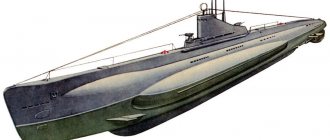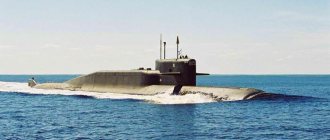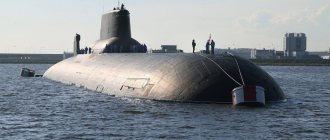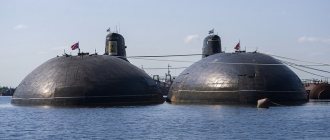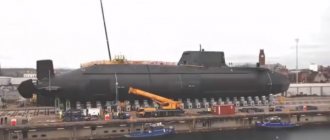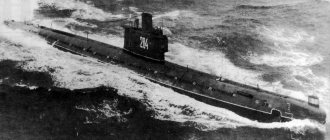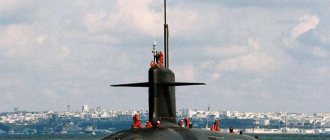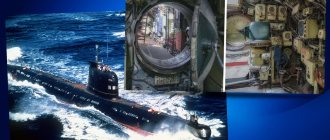In August 2011, the Bulava intercontinental ballistic missile was successfully launched to maximum range from the nuclear submarine Yuri Dolgoruky in the White Sea. Russia’s “nuclear triad” has strengthened in its most important component – the submarine fleet of missile-carrying ships. This is the strongest part of the triad, which the armed forces of any country are proud of.
The silent “city killer”
The submarine "Yuri Dolgoruky" belongs to the 4th generation strategic submarines. Its purpose is to destroy enemy ground strategic targets. It can deliver sixteen strikes at once, which is exactly how many deadly nuclear warheads it carries with a maximum flight range of more than 9 thousand kilometers and individual targeting units. This is the first and main ship of Project 955 - “Borey”. The submarine was built at Severodvinsk, and it joined the ranks of Russian nuclear submarines in 2008.
How will the United States be saved?
After this, Mr. Ney makes an unexpected conclusion: this is just a nightmare that will never happen in reality. The expert calls US nuclear submarines on patrol as a guarantee of this.
Question answer
What is the Dead Hand retaliatory system? “Four to five submarines, usually on combat duty, could send dozens of nuclear missiles at Russian targets, causing even greater devastation than would previously occur in the United States,” the author concludes.
Thus, according to the expert, the nuclear deterrent factor will prevent the worst-case scenario from happening in reality.
"Borey"
The history of the development of fourth-generation nuclear submarines was born at the Rubin design bureau (St. Petersburg) back in 1978. Project 955 Borey boats were supposed to replace the already outdated submarines 941 Akula (Typhoon) and 667 Dolphin (Delta-IV). These Russian submarines (NATO classification - Borei) have a displacement of up to 29 thousand tons, a length of 10 meters, dive to a depth of 400 meters at an underwater speed of 29 knots and are armed with the R-30 Bulava missile system, developed by the Institute of Thermal Engineering in Moscow.
Modifications
Project 955 "Borey-1" - SSBN for the D-31 missile system with 12 R-31 SLBMs. Design began in the mid-1980s.
Project 955 / 09550 "Borey" - SSBN for the D-19UTTH missile system with 12 "Bark" SLBMs. Design began in the late 1980s (1995 according to other data), development was stopped in 1998. The first boat laid down, K-535 “Yuri Dolgoruky” (serial number 201), was completed according to Project 09551.
Project 955 / 955(A) / 09551 “Borey” - SSBN for the D-30 missile system with 16 Bulava SLBMs. During construction, the backlog of submarines of projects 971 “Shchuka-B” and 949A “Antey” was used. Redesign began in September 1998 (completed in 1999).
Three ships were laid down and built:
- K-535 “Yuri Dolgoruky”, (serial number 201)
- K-550 "Alexander Nevsky", (serial number 202)
- K-551 "Vladimir Monomakh", (serial number 203)
Project 955A / 955U / 955M / 09552 “Borey-A” - SSBN, for the D-30 missile system with 16 Bulava SLBMs. According to media reports, the Borey-A project boats will differ from the base model by a lower level of physical fields, respectively, better stealth, more advanced means of communication, detection and weapons control. They will have improved crew habitability and survivability. Initially, there was information in the media about 20 Bulava missiles in the boats of this improved project, but later it was refuted. The groundwork for the first Borey-A boat is being prepared at the Northern Engineering Enterprise during 2009; construction actually started on December 22, 2009. The official laying of the 1st Borey-A SSBN was postponed by the Russian Ministry of Defense to 2010 The boats will be built without using old hulls. It is on the Borei-A submarines that the full potential of the fourth generation nuclear submarine project will be used.
Four ships were laid down:
- “Prince Vladimir” (serial number 204);
- “Prince Oleg” (serial number 205);
- "Generalissimo Suvorov" (serial number 206);
- "Emperor Alexander III" (serial number 207).
The first ship "Borey" project 995
In 1995, the nuclear submarine St. Petersburg appeared on the list of the Russian navy. Then the submarine changed its name in honor of the founder of Moscow, Yuri Dolgoruky, and under this name was laid down in the slipway workshops of Sevmash on November 2, 1996 in the presence of the then mayor of Moscow, Yuri Luzhkov. The boat's difficult journey to launch began. It suffered interruptions in financing and the cessation of supplies of components from Ukraine (special types of rolled metal for the propeller were manufactured at the Zaporozhye Metallurgical Plant). But in June 2009, the submarine Yuri Dolgoruky went to sea for sea trials. The cost of the ship was more than 23 billion rubles, but time has shown that these costs were not in vain.
Links[edit]
- ^ ab "Finally fluttering: the nuclear submarine "Yuri Dolgoruky" became part of the Russian Navy". RT.com
. January 10, 2013. Archived December 29, 2014. Retrieved April 19, 2015. CS1 maint: discouraged parameter (link) - Kommersant-Vlast - Sergei Ivanov handed over the submarine (in Russian). Kommersant.ru. April 23, 2007. Archived from the original on July 13, 2009. Retrieved April 19, 2015. CS1 maint: discouraged parameter (link)
- https://web.archive.org/web/20090712142605/https://www.interfax.com/3/364364/news.aspx. Archived from the original on July 12, 2009. Retrieved February 13, 2008. Missing or empty |title=( help )CS1 maint: discouraged parameter (link)
- "SSBN Yuri Dolgoruky completed sea trials". Rusnavy.com. September 28, 2010 archiving from the original on November 25, 2015. Retrieved April 19, 2015. CS1 maint: discouraged parameter (link)
- "SSBN Yuri Dolgoruky will launch torpedoes for the first time". Rusnavy.com. October 14, 2010 archiving from the original on October 6, 2014. Retrieved April 19, 2015. CS1 maint: discouraged parameter (link)
- A new test date for the Bulava has been announced (in Russian). Flot.com. December 15, 2010. Archived March 18, 2015. Retrieved April 19, 2015. CS1 maint: discouraged parameter (link)
- APK "Yuri Dolgoruky" will be introduced into the fleet in 2011, stated Ivanov (in Russian). Flot.com. December 14, 2010. Archived March 18, 2015. Retrieved April 19, 2015. CS1 maint: discouraged parameter (link)
- "The Vilyuchinsk base awaits the first Borey-class submarines with the Bulava". Rusnavy.com. October 20, 2010 archived from the original on November 25, 2015. Retrieved April 19, 2015. CS1 maint: discouraged parameter (link)
- "Bulava could enter service in 2011 if carrier submarine is ready". Rusnavy.com. December 21, 2010. Archived November 17, 2015. Retrieved April 19, 2015. CS1 maint: discouraged parameter (link)
- “New generation SSBN Yuri Dolgoruky entered sea trials”. Rusnavy.com. June 8, 2011. Archived November 29, 2014. Retrieved April 19, 2015. CS1 maint: discouraged parameter (link)
- “Russia tests launches of problematic Bulava rocket” after 8-month break | Defense | RIA News" . En.rian.ru. Archived from the original on September 2, 2011. Retrieved August 16, 2011. CS1 maint: discouraged parameter (link)
- "SSBN Yuri Dolgoruky almost joined Russian nuclear forces". www.rusnavy.com. January 12, 2012. Archived from the original on September 1, 2014. Retrieved October 19, 2014. CS1 maint: discouraged parameter (link)
- “Russian carrier submarines” Bulava “will be put into operation in the summer.” RIA News. February 9, 2012 Archived from the original on October 10, 2012. Retrieved October 19, 2014. CS1 maint: discouraged parameter (link)
- The nuclear submarine Yuri Dolgoruky will be handed over to the Navy on July 29, Rogozin confirmed (in Russian). RIA News. June 29, 2012. Archived October 19, 2014. Retrieved October 19, 2014. CS1 maint: discouraged parameter (link)
- "Russia to commission first Borei-class nuclear submarine in 2013". RIA News. October 22, 2012 Archived from the original on April 17, 2013. Retrieved October 19, 2014. CS1 maint: discouraged parameter (link)
- “The Ministry of Defense will pay a fine for failure to accept the SSBN Yuri Dolgoruky”. Rusnavy.com. October 26, 2012. Archived September 1, 2014. Retrieved October 19, 2014. CS1 maint: discouraged parameter (link)
- Stolesen, Atle (January 11, 2013). "Deadly submarine, now part of the Navy". Barents Observer
. Archived from the original on January 20, 2016. Retrieved October 19, 2014. CS1 maint: discouraged parameter (link) - "Yuri Dolgoruky" became part of the 31st submarine division of the Northern Fleet. RIA News
. January 10, 2013. Archived from the original on January 11, 2013. Retrieved December 19, 2014. CS1 maint: discouraged parameter (link) - Gutterman, Steve (January 10, 2013). "New Russian nuclear submarine enters service". Reuters
. Archived from the original on March 10, 2014. Retrieved October 19, 2014. CS1 maint: discouraged parameter (link) - Shoigu: the equipment of the Russian army with modern weapons and equipment increased by 7% over the year. ITAR-TASS
. December 19, 2014. Archived from the original on December 30, 2014. Retrieved December 27, 2014. CS1 maint: discouraged parameter (link) - "Archival copy". Archived from the original on March 26, 2016. Retrieved March 26, 2016.CS1 maint: archived copy as title (link)
Case Features
“Borey” is still largely secret today. For a long time, even photos of the submarine “Yuri Dolgoruky” were not available to the public. This fourth-generation one-and-a-half-hull single-shaft nuclear submarine has a cylindrical hull with 8 compartments:
- The first is the torpedo room, where the batteries and sonar equipment are located.
- The second is a command one with a central post and living quarters.
- The third is combat, there are missile launcher posts here.
- The fourth and fifth are the missile compartments themselves.
- Sixth – a steam generating plant is located here.
- The last two are energy, where the submarine’s nuclear reactor and turbine unit are located.
The robust hull is surrounded by a lightweight shell, between which are ballast tanks and fittings (double-hull design). In addition, the body is coated with a special rubberized compound. All equipment is installed on shock absorbers; each unit has its own shock absorption system. This reduces the noise level, increases buoyancy and makes it possible to work in Arctic latitudes.
Submarine "Yuri Dolgoruky": characteristics
For a better perception, we decided to compile all the characteristics into a table, which you can see below.
| Ship type | SSGN |
| Project | "Borey" 995 |
| Surface speed | 15 knots |
| Underwater speed | 29 knots |
| Autonomous swimming | 90 days |
| Crew | 107 people |
| Power point | Pressurized water reactor OK-650V |
| Dive depths | |
| Working | 400 meter |
| Maximum | 450 meters |
| Submarine dimensions | |
| Length | 170 meters |
| Width | 13.5 meters |
| Medium draft | 10 meters |
| Displacement | |
| Surface | 14.7 tons |
| underwater | 24 tons |
| Armament | |
| Torpedo-mine | Six 533 mm torpedo tubes, USET-80 torpedoes |
| Rocket | 16 R-30 (SS-NX-30) Bulava missiles |
Nuclear submarine K-535 Yury Dolgoruky (SSBN K-535 Yury Dolgoruky)
Emblem of the nuclear submarine K-535 Yury Dolgoruky (SSBN K-535 Yury Dolgoruky)
Nuclear submarine K-535 Yury Dolgoruky (SSBN Yury Dolgoruky) (according to NATO codification SSBN “Borei” or “Dolgoruky”) - nuclear submarine of Project 955 Borei (Project 955 Borei), class SSBN (strategic missile submarine cruiser) of the 4th generation , in the service of the Navy of the Russian Federation.
Nuclear submarine K-535 Yury Dolgoruky (SSBN K-535 Yury Dolgoruky)
Performance characteristics of the nuclear submarine K-535 Yury Dolgoruky (SSBN K-535 Yury Dolgoruky)
• Type of submarine - SSBN (Strategic Missile Submarine Cruiser) • Crew - 107 people • Surface displacement - 14,720 tons • Underwater displacement - 24,000 tons • Length (waterline) - 170 m • Width - 13.5 m • Draft - 10 ,0 m • Operating diving depth - 400 m • Maximum diving depth - 480 m • Underwater speed - 29 knots • Surface speed - 15 knots • Navigation autonomy - 90 days • Power plant - 1 OK-650V nuclear reactor, power 190 mW - 1 PTU with GTZA - 1 shaft - 1 water-jet propulsion • Torpedo-mine armament - 6 bow-mounted TAs of 533 mm caliber (Project 955) - 6 disposable launchers (PU) of 533 mm caliber REPS-324 Torpedo counter barrier - self-transporting mines • Missile weapons — 16 launchers of the D-30 Bulava complex • Ammunition — 16 SLBM R-30 Bulava (SS-NX-30) — 40 units — torpedoes UGST, USET-80 — missiles CRBD RK-55, PLRK Vodopad — self-transporting mines — 6 SGAPD ( anti-torpedoes)
The submarine K-535 Yury Dolgoruky (SSBN K-535 Yury Dolgoruky) is the lead ship of Project 955 Borei. On August 19, 1995, the K-535 submarine was included in the lists of ships of the Russian Navy, under the name "St. Petersburg". Already on May 1, 1996, it was decided to rename the submarine - from that moment on, K-535 bore the name K- 535 Yury Dolgoruky.
Nuclear submarine K-535 Yury Dolgoruky (SSBN K-535 Yury Dolgoruky) afloat
On November 2, 1996, in the city of Severodvinsk, in the slipway workshop No. 55 "Sevmash" the first submarine of project 955 (09550) "Borey" K-535 Yury Dolgoruky was laid down. In 1998, the project was finalized due to the abandonment of the Bark missile systems and received the index 09551. Also in 1998, work on the construction of the boat was completely stopped due to a serious reduction in project funding and the lack of the necessary alloys to build the boat elements that were supplied from Ukraine.
On September 5, 2003, the leadership of the Russian Navy fully formed the crew of the K-535 Yury Dolgoruky submarine. By 2005, the submarine's robust hull was completely completed. To speed up the construction of the durable hull of the K-535 nuclear submarine, the reserves of the K-137 Cougar submarine, which was created under Project 971 Shchuka-B, were used.
On April 15, 2007, the submarine was removed from the workshop to the floating dock of the Sukhona PD, and on February 12, 2008, the submarine was launched and outfitting work began. On November 11, 2008, the nuclear reactor of the nuclear submarine was launched. In March 2009, mooring tests began in several stages.
Poster of the layout of the nuclear submarine K-535 Yury Dolgoruky (K-535 Yury Dolgoruky)
In mid-June 2011, the first sea trials were completed, and at the end of June of the same year, the first launch of the Bulava SLBM was carried out, which was completed successfully. Also, Yury Dolgoruky K-535 Yury Dolgoruky made test launches of the Bulava K-535 on August 27 and October 28, 2011. The launches were successful.
On December 23, 2011, the first salvo launch of the Bulava SLBM was carried out from the nuclear submarine K-535 Yury Dolgoruky at the Kura training ground, which was completed successfully.
In February 2012, the nuclear submarine K-535 Yury Dolgoruky underwent a commissioning test program.
On July 7, 2012, the state testing program was completed.
On January 10, 2013, a solemn ceremony of raising the flag on the nuclear submarine Yury Dolgoruky (K-535 Yury Dolgoruky) took place. The submarine was assigned to the 31st Submarine Division (DiPL) of the Northern Fleet (SF), which is based in Gadzhievo, Murmansk region. On September 9, 2013, the submarine arrived in Gadzhievo, its permanent base. On December 8 of the same year, the nuclear submarine went to Sevmash for repairs.
On July 27, 2014, the nuclear submarine K-535 Yury Dolgoruky took part in the naval parade in Severomorsk on Russian Navy Day.
SSBN K-535 Yury Dolgoruky (K-535 Yury Dolgoruky), rear view
On October 29, 2014, an intercontinental ballistic missile (ICBM) with the K-535 Yury Dolgoruky SSBN was successfully launched at the Kura test site in Kamchatka.
On October 15, 2015, the nuclear submarine K-535 Yury Dolgoruky completed its first combat duty in the Arctic, which lasted two months. The submarine arrived at the Northern Fleet base Gadzhievo.
On September 27, 2016, two Bulava ballistic missiles were launched from an underwater position at the Kura test site in Kamchatka. One missile hit the target, the other self-destructed.
On June 26, 2022, the Bulava rocket was launched as planned at the Kura test site. Everything went as normal.
On May 22, 2022, the nuclear submarine K-535 Yury Dolgoruky for the first time fired four Bulava missiles in one salvo at the Kura test site, Kamchatka.
On August 24, 2022, the missile submarine cruiser K-535 Yury Dolgoruky routinely fired a missile at the Kamchatka Kura test site.
Design Features
Borei submarines have unique noise characteristics - they are five times quieter than all previous Russian submarines. The Yuri Dolgoruky submarine is propelled by a single-shaft water jet engine with high propulsion characteristics, which significantly reduces the degree of cavitation - the main noise producer when the submarine moves. Control is carried out using two folding thrusters and retractable bow horizontal rudders with flaps. The automated unified system "Okrug-55" ensures the coordinated operation of all the ship's equipment. A pop-up rescue chamber and five KSU-600N-4 rafts are designed to rescue the entire crew.
Hydroacoustics
The Irtysh-Amphora-B-055 hydroacoustics complex is superior in range to its counterparts found on the US Navy Virginia boats. The complex consists of an antenna and the digital processing system itself. In addition there is a towing antenna and side antennas.
Noise bearing, echo direction finding, target classification, determining ice thickness, searching for mines and detecting torpedoes - all these are tasks performed by the hydroacoustic complex of the Yuri Dolgoruky submarine. Tracking up to thirty targets simultaneously and detecting the enemy at a distance of up to 230 kilometers is a common task for this submarine.
Power point
The fourth generation VM-5 nuclear reactor, operating on thermal neutrons, provides the speed characteristics of the boat. In addition, there is an information and management system for controlling and monitoring radiation levels. The energy component is added by a steam generating unit with a capacity of 190 MW and an Azurit-90 turbine unit.
